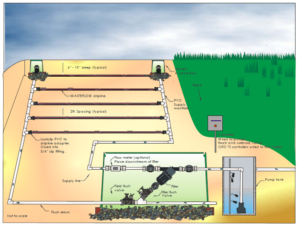Geoflow WASTEFLOW®
Geoflow’s subsurface drip systems solve many of the problems that plague traditional methods of wastewater dispersal. Since the effluent is dispersed underground where it is absorbed in the biologically active soil layer, there is no surface contamination, no ponding, no run-off problems, no bad smells. Issues such as overspray and aerosol drift are eliminated, dose scheduling is unaffected by land use or weather, and it is a politically and environmentally favorable means of dispersing wastewater. With subsurface drip, secondary reclaimed wastewater can be used, eliminating the ongoing cost of additional effluent treatment. Geoflow drip dispersal is recommended for commercial, municipal, industrial, residential and agricultural applications.
 How It Works
How It Works
The WASTEFLOW dripline has factory-installed emitters evenly spaced along the tubing. The dripline is usually installed six to ten inches below the surface, directly into the biologically active soil horizon where the treated effluent can be absorbed by the plants, animal life, and soil. Wastewater is pumped to the dripfield on a time-activated dose cycle. The slow, even application of effluent with resting periods is key to the drip system’s success.
Easy to Install – New or Retrofit
Geoflow subsurface systems are simple to install. The tubing can be laid on a graded parcel then covered with topsoil or installed using a tubing plow or trencher. Subsurface drip also solves the problem of small or odd-shaped areas, such as property edges and around buildings and other structures. The flexible tubing can easily be fit to uneven spaces. Since the wetted area is within close proximity of each emitter, run-off problems are easily eliminated.
 But What About…?
But What About…?
Clogging– Geoflow drip systems are installed with self-cleaning filters to keep large particles from entering the drip field. WASTEFLOW emitters are also self-cleaning and have been used for over 15 years in actual onsite applications. They are made with large orifices, raised entry ports, and turbulent flow paths to keep smaller particles from collecting in the emitters.
Root intrusion– Each emitter features ROOTGUARD®-patented protection against roots entering the emitters. Tile non-toxic active ingredient, Treflan®, directs root growth away from the emitters. Treflan is impregnated into the emitters during the molding process.
Bacterial growth– Geoflow’s WASTEFLOW dripline is coated inside with the anti-bacterial, Ultra-Fresh® to inhibit bacterial growth on the walls of the tube and in the emitters. Ultra-Fresh has been found to be effective in preventing slime build-up inside the tube, even with effluent that has very high BOD. This eliminates the need to scour the dripline with high flush velocities. There is virtually no discharge into the environment because the active ingredient, TBT-maleate, does not migrate readily through plastic (Note: Ultra-Fresh does not treat the water flowing through the tube.)
Freezing climates– Geoflow systems can be used year round, even in freezing conditions. The polyethylene dripline is flexible enough so as not to crack when it freezes. The dripline self-drains through the emitters every time the system is turned off, and will not hold water. Sound design, including drain back of the system, air vacuum breakers and insulation of the more rigid parts of the system keep the system working even in the coldest climates.
Difficult sites– Geoflow systems can be effective in areas with
- tight soils
- rocky terrains
- steep slopes
- high water tables












